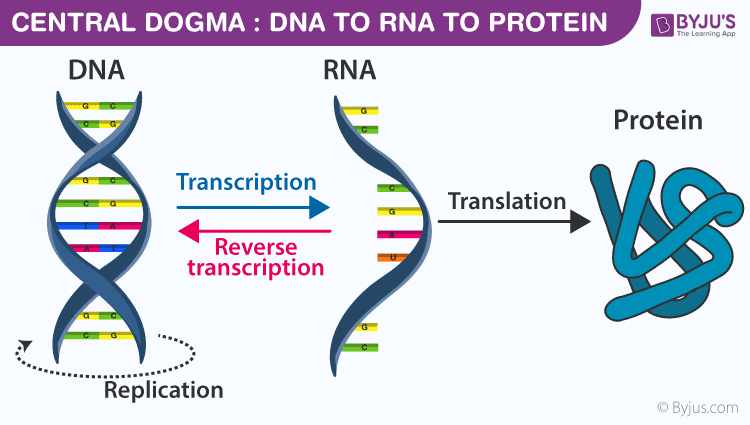Protein Synthesis Central DogmaStructure of tRNAProtein Biosynthesis – TranslationFrequently Asked Questions
Protein Synthesis – Central Dogma
The central dogma describes how the DNA makes its own copies by DNA replication, then codes for the RNA by means of a transcription and RNA codes for the proteins by translation.
For the creation of a new generation, the genetic information stored in the DNA has to be transferred from one generation to another. The process begins with the replication of DNA followed by transcription and translation. Let us have a discussion on translation viz. protein synthesis in cell and the structure of tRNA.

Structure of tRNA
The DNA is transcribed into mRNA on the basis of their complementarity. Translation is the process of conversion of nucleic acid information into amino acids. There is no complementarity between amino acids and mRNA. Hence, translation is not controlled by complementarity but by the genetic code. Since amino acids cannot read this genetic code, they are dependent on an adapter molecule. This adapter molecule is called tRNA (transfer RNA).

Structurally, the tRNA is an inverted L-shaped molecule which has an anticodon loop and amino acid acceptor end. The anticodon loop makes bases complementary to the codes on the mRNA and amino acid end binds to the respective amino acids. Thus, it helps in protein synthesis. Each amino acid has a specific tRNA. Initiator tRNA initiates the translation while stop codons have no tRNA.
Protein Biosynthesis – Translation
The process by which the mRNA codes for a particular protein is known as Translation. In the process, the ribosome translates the mRNA produced from DNA into a chain of specific amino acids. This chain of amino acids leads to protein synthesis.
It is a process where the expense of ATP is required and this energy is given by the charged tRNA. The whole machinery of translation is present in the ribosomes.
Read more: tRNA Charging or Amino Acid Activation
The ribosomes consist of a bigger subunit and a smaller subunit. The larger subunit, in turn, consists of two molecules of tRNA that are placed close so that peptide bond could be developed at the expense of sufficient energy. The mRNA enters the smaller subunit which is held by the molecules of tRNA of the complementary codon, that exists in the bigger subunit. Hence, two codons are held by two molecules of tRNA, placed near to each other and a peptide bond is produced among them. When this process repeats, a large chain of amino acids is synthesized. At the stop, codon ribosome releases the amino acid chain.
Frequently Asked Questions
How does protein synthesis occurs in prokaryotes?
In prokaryotes, which lack a nucleus, the processes of both transcription and translation occur in the cytoplasm. The protein biosynthesis begins by the association of a 30s ribosomal subunit and an mRNA at the AUG codon site. Also the post-transcriptional modifications are not required here and the mature mRNA molecule is immediately produced by transcription.
How does protein synthesis occurs in eukaryotes?
In eukaryotes, the pre-mRNA undergoes post-transcriptional modifications in the nucleus to produce a mature mRNA molecule. The translation occurs in the cytoplasm of the cell, where the ribosomes are located either free-floating or attached to the endoplasmic reticulum. Here, the initiation of protein synthesis is the process that results in bringing together an 80S ribosome with an mRNA and initiator methionyl-transfer RNA.
Information about protein synthesis is stored in the ___________.
The DNA stores information about protein synthesis, and the body requires the synthesis of the right proteins in accordance with its needs. These proteins are produced by DNA through RNA and are referred to as the Central Dogma.
Where does protein synthesis take place?
Protein synthesis takes place inside the cell. It occurs in the cytoplasm of prokaryotes. In eukaryotes, the coding sequence of the DNA is first transcribed into mRNA in the nucleus. The transcript exits the nucleus and travels to the ribosomes, where it is translated into a protein molecule with a predetermined amino acid sequence.
Explain: DNA to mRNA to protein.
Transcription is a process that converts DNA information into a messenger RNA (mRNA) molecule in the initial stage. During transcription, RNA polymerase II catalyses the synthesis of a pre-mRNA molecule, later processed to become mature mRNA. The DNA of a gene acts as a template for complementary base pairing. The resulting mRNA contains a single-stranded copy of the gene that needs to be converted into a protein molecule. The mRNA is “read” following the genetic code, which connects the DNA sequence to the amino acid sequence in proteins during translation, the second major stage in gene expression. A codon is a collection of three nucleotides found in mRNA, and each codon encodes an individual amino acid (triplet code).
What is the process of RNA to protein synthesis called?
The process of synthesising proteins from mRNA is known as translation and takes place in the ribosome. After leaving the nucleus, mRNA is carried to the ribosomes on the ER and translated into proteins. By reading specific codons and employing transport (tRNA) to insert the matching amino acid into the sequence, these ribosomes successfully add amino acids.
What is the role of amino acids in protein synthesis?
Amino acids have a wide range of functions. Their main job is to serve as the monomer in producing new proteins. The nucleotide bases and various neurotransmitters and hormones are generated from amino acids, which can also be utilised as substrates for biosynthetic reactions.

For more video lessons on translation and protein synthesis, visit BYJU’S.

Thank you for your help
View translation structure and details please
I want to prepare for hbse